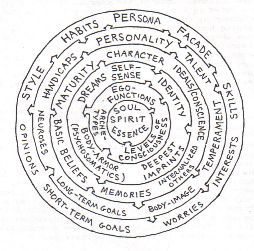COMPLEXITIES OF MIND
Adam Blatner
January16, 2007
Human life is lived at
many levels. First, of course, we are embedded physically in a
material universe:
There we are in the middle.
At the physical level, we are composed of a number of levels of
bodily organization, and at each level there are many components that
all interact:

|
And yet, this is only the physical level. Each element at any level has
its own patterns of reactivity or "life-like" reactivity and
interrelationships with other elements at its own level as well as many
of the elements at levels "below" and "above its own. There is thus a
mind-like dimension, something that experiences and reacts, even at
levels that are too simple to sustain self-reflective consciousness.
This last is that level of mind that knows that it is thinking, that is
able to say, as did Descartes, "I think, therefore I exist" (or, as he
wrote this in Latin in his essay, "Cogito, ergo sum.").
The mental dimension of human existence is similarly complex. First,
neuroscience has found that many elements of individual mental
functioning is deeply influenced byt the state of the brain, its
nutrients, transmitter chemicals, anatomical and physical functioning,
and so forth.
Second, people function equally at several levels, both consciously and
sub-consciously:

|
The contemporary philosopher, Ken Wilber, calls these levels "holons,"
and notes that it is a hierarchy not of power, like the social
hierarchies of humanity, with king, duke, knight, peasant, peasant's
wife, child, but rather a hierarchy of simple inclusiveness, in the
sense that each holon includes a number of holons and in turn is
included along with others at its own level in a series of wider holons.
An interesting problem with these holons, or the various elements at
the different level: They are not discrete, having nice boundaries.
Rather, they overlap, inter-penetrate. Often one element is an
intrinsic part of another, and vice versa. In the realm of mind,
especially, many logical principles don't work. Things are not
either-or, but often both-and in nature.
Another feature of the mental dimensions and organismic dimensions is
that, unlike some simple machines, the whole is more than the sum of
its parts, and this is true at every level. (In other words,
"reductionistic" analysis can only be useful within limits and for
certain purposes.) Each level of complexity exhibits what is known as
"emergent" properties, so that a cell, for example, has more capacity
for what is thought of as life than any of its cellular components, or
all of them laid side by side. When they are assembled just so, they
operate as more than just the sum of their parts. Similarly, an organ
has more functions than are possible by any single cell, and the
organism has more "life" than the mere sum of its organs.
As noted in an associated paper on this website, collectives
of humans also show emergent properties and a kind of life not
accessible by individuals. Also we are embedded in a "holarchy" of levels of psycho-social elements, as described
in yet a third paper. And within our relationships, we relate often not
just through one role, but many, and
this is illustrated in yet a fourth paper on this website.
Finally, many psychological phenomena should be recognized as being
made of many elements---what I call "aggregate experiences." In a
fifth associated paper, I describe how the sense
of self is thus organized, and I also think our spiritual
experience of "God," however it may be viewed monotheistically in its
conceptualization, is, at a mental level, constructed out of many
component experiences. This is further discussed also in a paper (as
yet unpublished.) Family, and many other dimensions may also be
aggregate experiences.
This paper has been posted to support an appreciation of the complexity
of our being in the world. A sixth paper speaks to the many factors that go into human development.
For further questions or suggestions, email me at adam@blatner.com









